HRM, CPM, Utilitarianism: Balancing Employee Welfare and Company Goals
VerifiedAdded on 2021/05/30
|8
|2072
|48
Essay
AI Summary
This essay delves into the intricate relationship between Human Resource Management (HRM), Contemporary People Management (CPM), and Utilitarianism within the context of organizational management. It defines HRM as a formal system for managing people, encompassing responsibilities like compensation, staffing, and design, with the aim of optimizing worker effectiveness and aligning the workforce to achieve business goals. CPM is presented as an extension of HRM, focused on creating a work environment that prioritizes employees as valuable assets. Utilitarianism, as a core ethical framework, is introduced as the principle of maximizing happiness and minimizing pain, with its application in employee welfare. The essay argues for the reconciliation of these management philosophies through a mixed strategy that balances worker well-being and organizational growth. It emphasizes the importance of clear communication, fair treatment, and the recognition of employees as the primary resource of the organization. The paper also highlights the roles of managers in fostering a positive work environment, motivating employees, and ensuring that both individual and company goals are met, ultimately contributing to the success of the organization by fostering employee satisfaction and productivity.
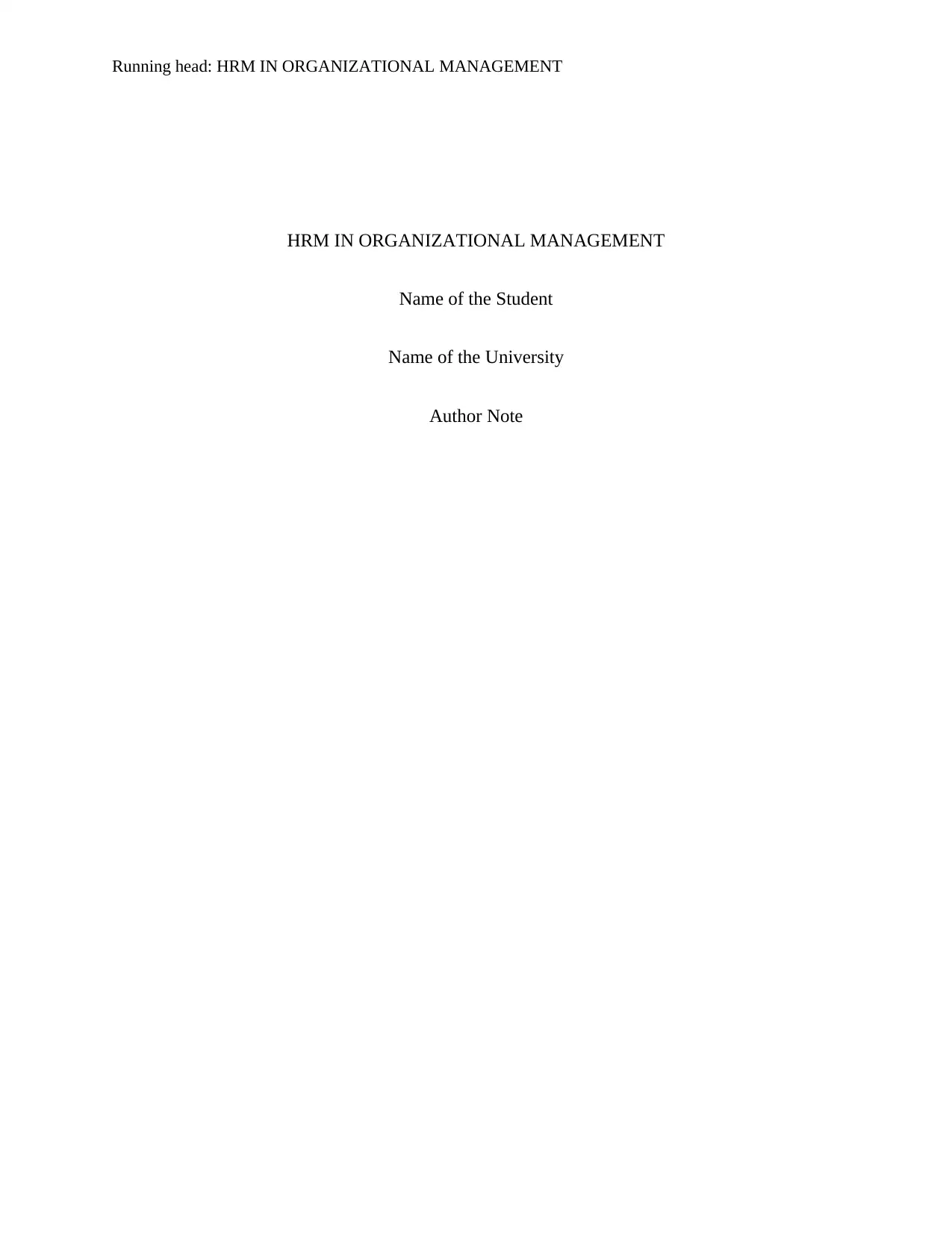
Running head: HRM IN ORGANIZATIONAL MANAGEMENT
HRM IN ORGANIZATIONAL MANAGEMENT
Name of the Student
Name of the University
Author Note
HRM IN ORGANIZATIONAL MANAGEMENT
Name of the Student
Name of the University
Author Note
Paraphrase This Document
Need a fresh take? Get an instant paraphrase of this document with our AI Paraphraser
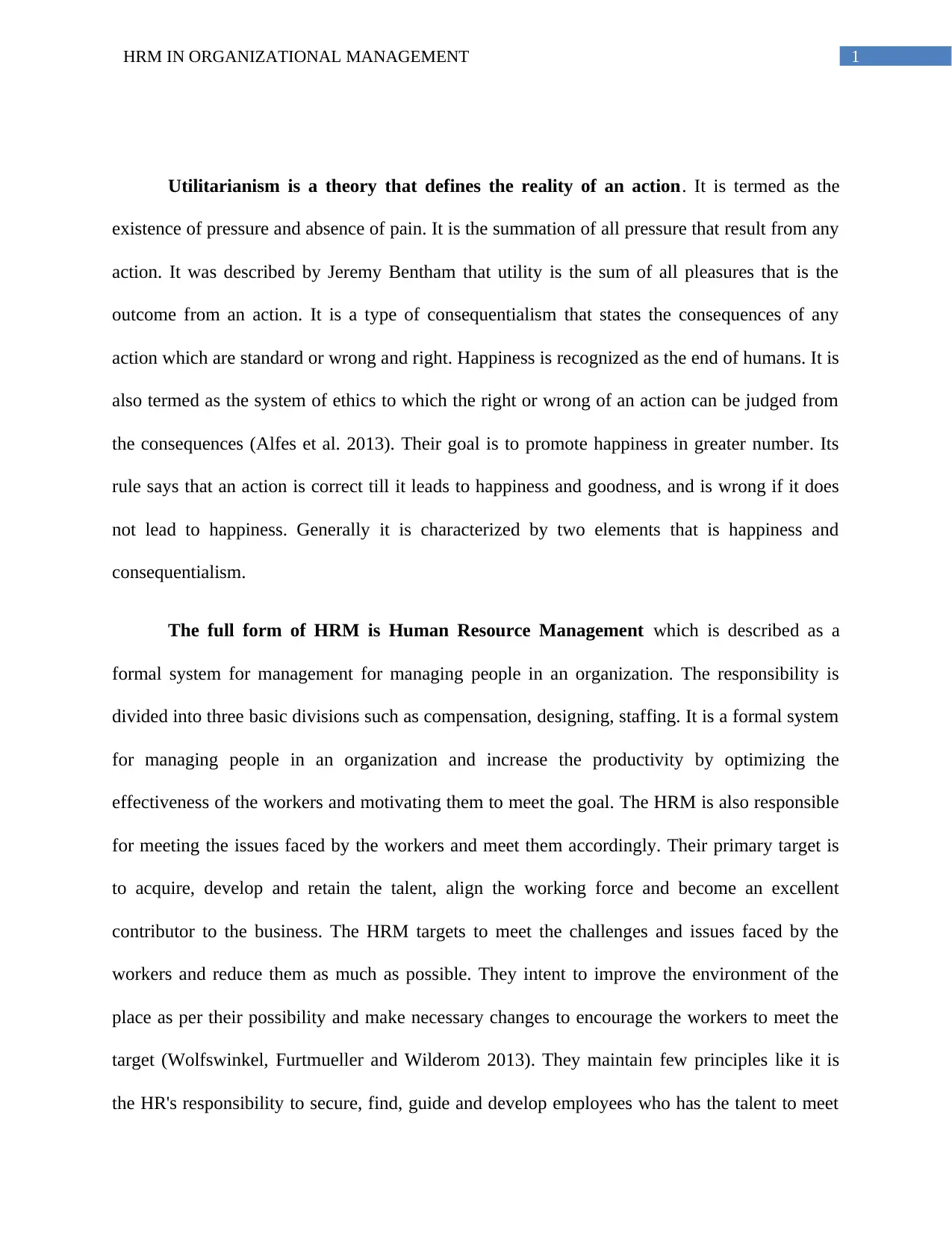
1HRM IN ORGANIZATIONAL MANAGEMENT
Utilitarianism is a theory that defines the reality of an action. It is termed as the
existence of pressure and absence of pain. It is the summation of all pressure that result from any
action. It was described by Jeremy Bentham that utility is the sum of all pleasures that is the
outcome from an action. It is a type of consequentialism that states the consequences of any
action which are standard or wrong and right. Happiness is recognized as the end of humans. It is
also termed as the system of ethics to which the right or wrong of an action can be judged from
the consequences (Alfes et al. 2013). Their goal is to promote happiness in greater number. Its
rule says that an action is correct till it leads to happiness and goodness, and is wrong if it does
not lead to happiness. Generally it is characterized by two elements that is happiness and
consequentialism.
The full form of HRM is Human Resource Management which is described as a
formal system for management for managing people in an organization. The responsibility is
divided into three basic divisions such as compensation, designing, staffing. It is a formal system
for managing people in an organization and increase the productivity by optimizing the
effectiveness of the workers and motivating them to meet the goal. The HRM is also responsible
for meeting the issues faced by the workers and meet them accordingly. Their primary target is
to acquire, develop and retain the talent, align the working force and become an excellent
contributor to the business. The HRM targets to meet the challenges and issues faced by the
workers and reduce them as much as possible. They intent to improve the environment of the
place as per their possibility and make necessary changes to encourage the workers to meet the
target (Wolfswinkel, Furtmueller and Wilderom 2013). They maintain few principles like it is
the HR's responsibility to secure, find, guide and develop employees who has the talent to meet
Utilitarianism is a theory that defines the reality of an action. It is termed as the
existence of pressure and absence of pain. It is the summation of all pressure that result from any
action. It was described by Jeremy Bentham that utility is the sum of all pleasures that is the
outcome from an action. It is a type of consequentialism that states the consequences of any
action which are standard or wrong and right. Happiness is recognized as the end of humans. It is
also termed as the system of ethics to which the right or wrong of an action can be judged from
the consequences (Alfes et al. 2013). Their goal is to promote happiness in greater number. Its
rule says that an action is correct till it leads to happiness and goodness, and is wrong if it does
not lead to happiness. Generally it is characterized by two elements that is happiness and
consequentialism.
The full form of HRM is Human Resource Management which is described as a
formal system for management for managing people in an organization. The responsibility is
divided into three basic divisions such as compensation, designing, staffing. It is a formal system
for managing people in an organization and increase the productivity by optimizing the
effectiveness of the workers and motivating them to meet the goal. The HRM is also responsible
for meeting the issues faced by the workers and meet them accordingly. Their primary target is
to acquire, develop and retain the talent, align the working force and become an excellent
contributor to the business. The HRM targets to meet the challenges and issues faced by the
workers and reduce them as much as possible. They intent to improve the environment of the
place as per their possibility and make necessary changes to encourage the workers to meet the
target (Wolfswinkel, Furtmueller and Wilderom 2013). They maintain few principles like it is
the HR's responsibility to secure, find, guide and develop employees who has the talent to meet
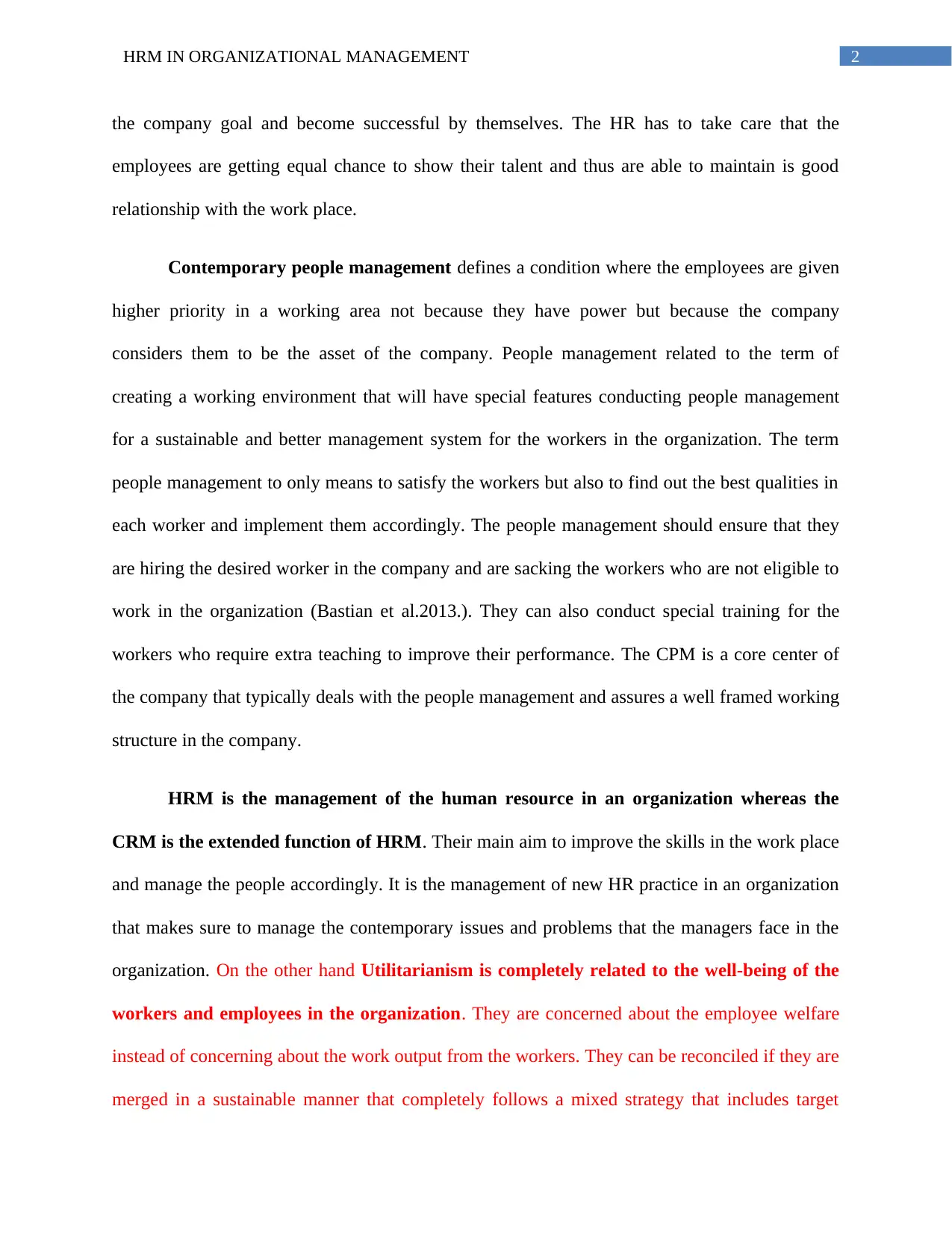
2HRM IN ORGANIZATIONAL MANAGEMENT
the company goal and become successful by themselves. The HR has to take care that the
employees are getting equal chance to show their talent and thus are able to maintain is good
relationship with the work place.
Contemporary people management defines a condition where the employees are given
higher priority in a working area not because they have power but because the company
considers them to be the asset of the company. People management related to the term of
creating a working environment that will have special features conducting people management
for a sustainable and better management system for the workers in the organization. The term
people management to only means to satisfy the workers but also to find out the best qualities in
each worker and implement them accordingly. The people management should ensure that they
are hiring the desired worker in the company and are sacking the workers who are not eligible to
work in the organization (Bastian et al.2013.). They can also conduct special training for the
workers who require extra teaching to improve their performance. The CPM is a core center of
the company that typically deals with the people management and assures a well framed working
structure in the company.
HRM is the management of the human resource in an organization whereas the
CRM is the extended function of HRM. Their main aim to improve the skills in the work place
and manage the people accordingly. It is the management of new HR practice in an organization
that makes sure to manage the contemporary issues and problems that the managers face in the
organization. On the other hand Utilitarianism is completely related to the well-being of the
workers and employees in the organization. They are concerned about the employee welfare
instead of concerning about the work output from the workers. They can be reconciled if they are
merged in a sustainable manner that completely follows a mixed strategy that includes target
the company goal and become successful by themselves. The HR has to take care that the
employees are getting equal chance to show their talent and thus are able to maintain is good
relationship with the work place.
Contemporary people management defines a condition where the employees are given
higher priority in a working area not because they have power but because the company
considers them to be the asset of the company. People management related to the term of
creating a working environment that will have special features conducting people management
for a sustainable and better management system for the workers in the organization. The term
people management to only means to satisfy the workers but also to find out the best qualities in
each worker and implement them accordingly. The people management should ensure that they
are hiring the desired worker in the company and are sacking the workers who are not eligible to
work in the organization (Bastian et al.2013.). They can also conduct special training for the
workers who require extra teaching to improve their performance. The CPM is a core center of
the company that typically deals with the people management and assures a well framed working
structure in the company.
HRM is the management of the human resource in an organization whereas the
CRM is the extended function of HRM. Their main aim to improve the skills in the work place
and manage the people accordingly. It is the management of new HR practice in an organization
that makes sure to manage the contemporary issues and problems that the managers face in the
organization. On the other hand Utilitarianism is completely related to the well-being of the
workers and employees in the organization. They are concerned about the employee welfare
instead of concerning about the work output from the workers. They can be reconciled if they are
merged in a sustainable manner that completely follows a mixed strategy that includes target
⊘ This is a preview!⊘
Do you want full access?
Subscribe today to unlock all pages.

Trusted by 1+ million students worldwide
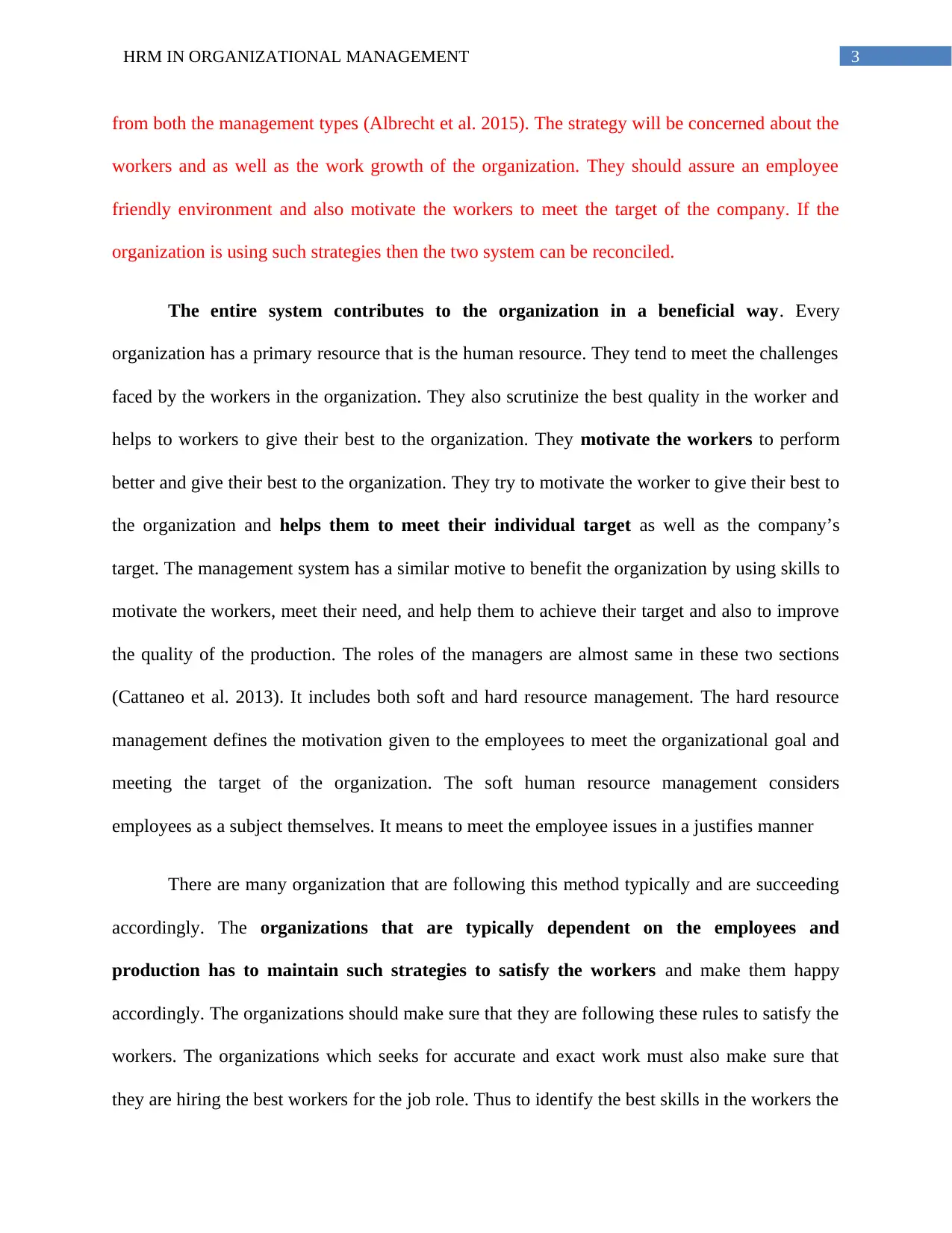
3HRM IN ORGANIZATIONAL MANAGEMENT
from both the management types (Albrecht et al. 2015). The strategy will be concerned about the
workers and as well as the work growth of the organization. They should assure an employee
friendly environment and also motivate the workers to meet the target of the company. If the
organization is using such strategies then the two system can be reconciled.
The entire system contributes to the organization in a beneficial way. Every
organization has a primary resource that is the human resource. They tend to meet the challenges
faced by the workers in the organization. They also scrutinize the best quality in the worker and
helps to workers to give their best to the organization. They motivate the workers to perform
better and give their best to the organization. They try to motivate the worker to give their best to
the organization and helps them to meet their individual target as well as the company’s
target. The management system has a similar motive to benefit the organization by using skills to
motivate the workers, meet their need, and help them to achieve their target and also to improve
the quality of the production. The roles of the managers are almost same in these two sections
(Cattaneo et al. 2013). It includes both soft and hard resource management. The hard resource
management defines the motivation given to the employees to meet the organizational goal and
meeting the target of the organization. The soft human resource management considers
employees as a subject themselves. It means to meet the employee issues in a justifies manner
There are many organization that are following this method typically and are succeeding
accordingly. The organizations that are typically dependent on the employees and
production has to maintain such strategies to satisfy the workers and make them happy
accordingly. The organizations should make sure that they are following these rules to satisfy the
workers. The organizations which seeks for accurate and exact work must also make sure that
they are hiring the best workers for the job role. Thus to identify the best skills in the workers the
from both the management types (Albrecht et al. 2015). The strategy will be concerned about the
workers and as well as the work growth of the organization. They should assure an employee
friendly environment and also motivate the workers to meet the target of the company. If the
organization is using such strategies then the two system can be reconciled.
The entire system contributes to the organization in a beneficial way. Every
organization has a primary resource that is the human resource. They tend to meet the challenges
faced by the workers in the organization. They also scrutinize the best quality in the worker and
helps to workers to give their best to the organization. They motivate the workers to perform
better and give their best to the organization. They try to motivate the worker to give their best to
the organization and helps them to meet their individual target as well as the company’s
target. The management system has a similar motive to benefit the organization by using skills to
motivate the workers, meet their need, and help them to achieve their target and also to improve
the quality of the production. The roles of the managers are almost same in these two sections
(Cattaneo et al. 2013). It includes both soft and hard resource management. The hard resource
management defines the motivation given to the employees to meet the organizational goal and
meeting the target of the organization. The soft human resource management considers
employees as a subject themselves. It means to meet the employee issues in a justifies manner
There are many organization that are following this method typically and are succeeding
accordingly. The organizations that are typically dependent on the employees and
production has to maintain such strategies to satisfy the workers and make them happy
accordingly. The organizations should make sure that they are following these rules to satisfy the
workers. The organizations which seeks for accurate and exact work must also make sure that
they are hiring the best workers for the job role. Thus to identify the best skills in the workers the
Paraphrase This Document
Need a fresh take? Get an instant paraphrase of this document with our AI Paraphraser
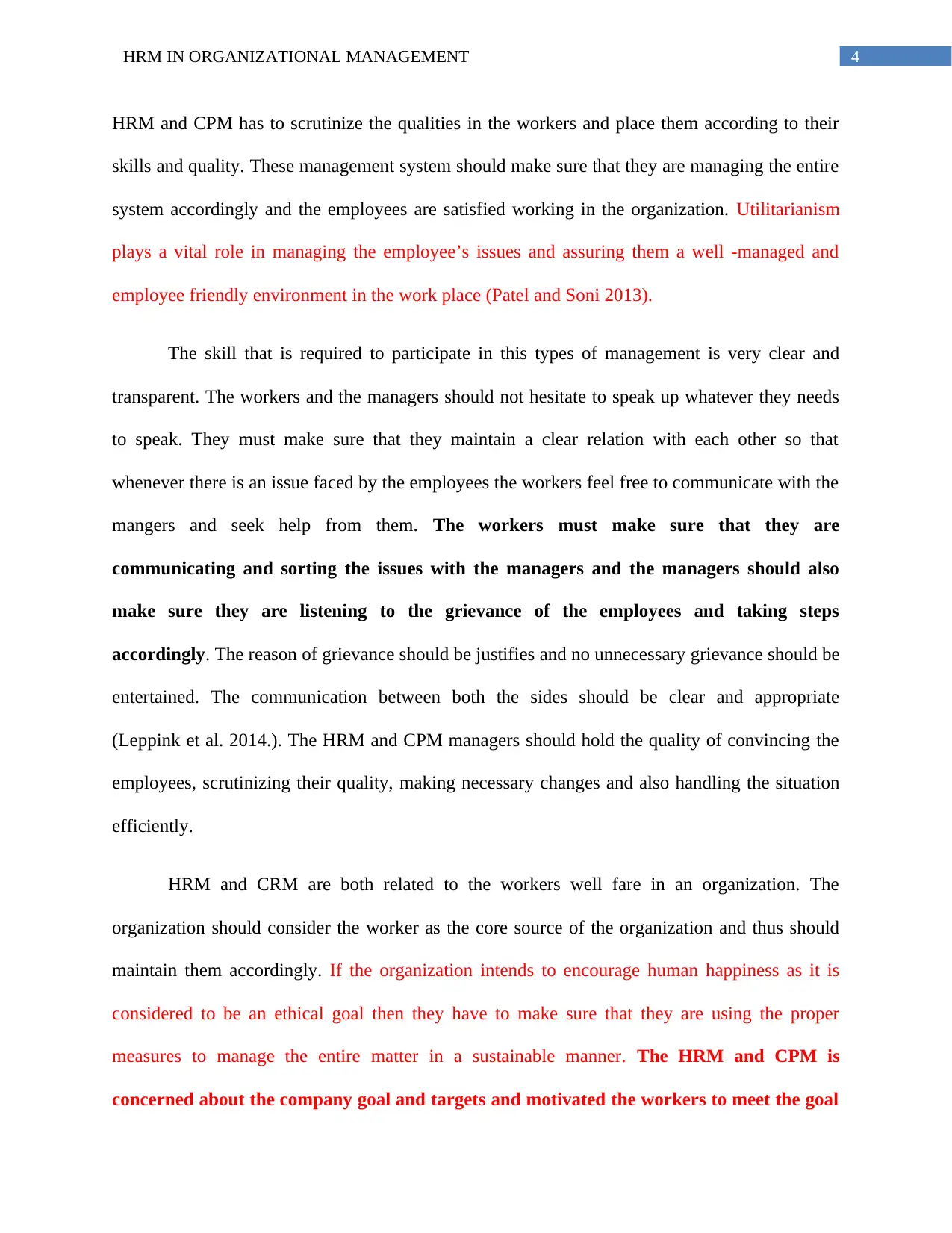
4HRM IN ORGANIZATIONAL MANAGEMENT
HRM and CPM has to scrutinize the qualities in the workers and place them according to their
skills and quality. These management system should make sure that they are managing the entire
system accordingly and the employees are satisfied working in the organization. Utilitarianism
plays a vital role in managing the employee’s issues and assuring them a well -managed and
employee friendly environment in the work place (Patel and Soni 2013).
The skill that is required to participate in this types of management is very clear and
transparent. The workers and the managers should not hesitate to speak up whatever they needs
to speak. They must make sure that they maintain a clear relation with each other so that
whenever there is an issue faced by the employees the workers feel free to communicate with the
mangers and seek help from them. The workers must make sure that they are
communicating and sorting the issues with the managers and the managers should also
make sure they are listening to the grievance of the employees and taking steps
accordingly. The reason of grievance should be justifies and no unnecessary grievance should be
entertained. The communication between both the sides should be clear and appropriate
(Leppink et al. 2014.). The HRM and CPM managers should hold the quality of convincing the
employees, scrutinizing their quality, making necessary changes and also handling the situation
efficiently.
HRM and CRM are both related to the workers well fare in an organization. The
organization should consider the worker as the core source of the organization and thus should
maintain them accordingly. If the organization intends to encourage human happiness as it is
considered to be an ethical goal then they have to make sure that they are using the proper
measures to manage the entire matter in a sustainable manner. The HRM and CPM is
concerned about the company goal and targets and motivated the workers to meet the goal
HRM and CPM has to scrutinize the qualities in the workers and place them according to their
skills and quality. These management system should make sure that they are managing the entire
system accordingly and the employees are satisfied working in the organization. Utilitarianism
plays a vital role in managing the employee’s issues and assuring them a well -managed and
employee friendly environment in the work place (Patel and Soni 2013).
The skill that is required to participate in this types of management is very clear and
transparent. The workers and the managers should not hesitate to speak up whatever they needs
to speak. They must make sure that they maintain a clear relation with each other so that
whenever there is an issue faced by the employees the workers feel free to communicate with the
mangers and seek help from them. The workers must make sure that they are
communicating and sorting the issues with the managers and the managers should also
make sure they are listening to the grievance of the employees and taking steps
accordingly. The reason of grievance should be justifies and no unnecessary grievance should be
entertained. The communication between both the sides should be clear and appropriate
(Leppink et al. 2014.). The HRM and CPM managers should hold the quality of convincing the
employees, scrutinizing their quality, making necessary changes and also handling the situation
efficiently.
HRM and CRM are both related to the workers well fare in an organization. The
organization should consider the worker as the core source of the organization and thus should
maintain them accordingly. If the organization intends to encourage human happiness as it is
considered to be an ethical goal then they have to make sure that they are using the proper
measures to manage the entire matter in a sustainable manner. The HRM and CPM is
concerned about the company goal and targets and motivated the workers to meet the goal
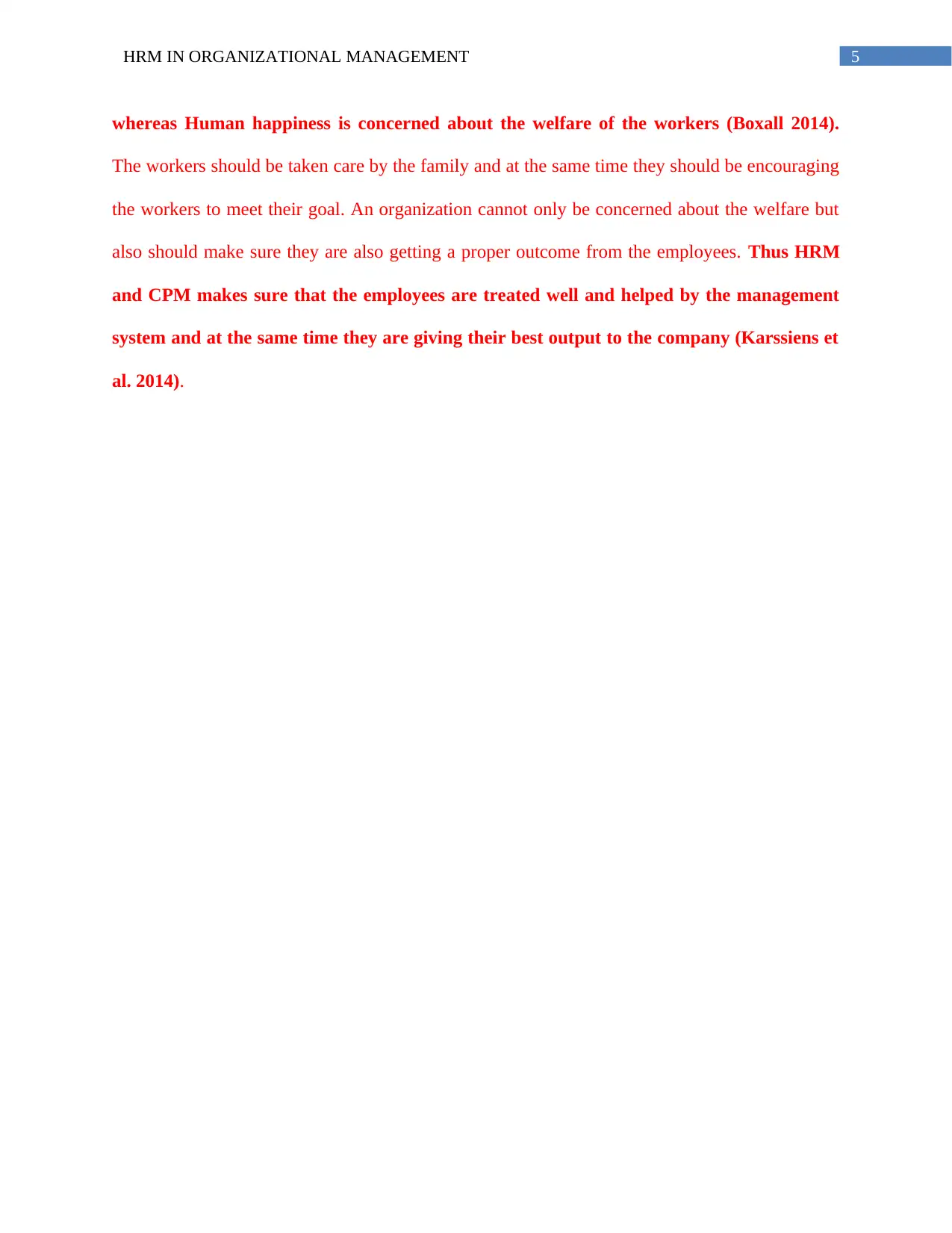
5HRM IN ORGANIZATIONAL MANAGEMENT
whereas Human happiness is concerned about the welfare of the workers (Boxall 2014).
The workers should be taken care by the family and at the same time they should be encouraging
the workers to meet their goal. An organization cannot only be concerned about the welfare but
also should make sure they are also getting a proper outcome from the employees. Thus HRM
and CPM makes sure that the employees are treated well and helped by the management
system and at the same time they are giving their best output to the company (Karssiens et
al. 2014).
whereas Human happiness is concerned about the welfare of the workers (Boxall 2014).
The workers should be taken care by the family and at the same time they should be encouraging
the workers to meet their goal. An organization cannot only be concerned about the welfare but
also should make sure they are also getting a proper outcome from the employees. Thus HRM
and CPM makes sure that the employees are treated well and helped by the management
system and at the same time they are giving their best output to the company (Karssiens et
al. 2014).
⊘ This is a preview!⊘
Do you want full access?
Subscribe today to unlock all pages.

Trusted by 1+ million students worldwide
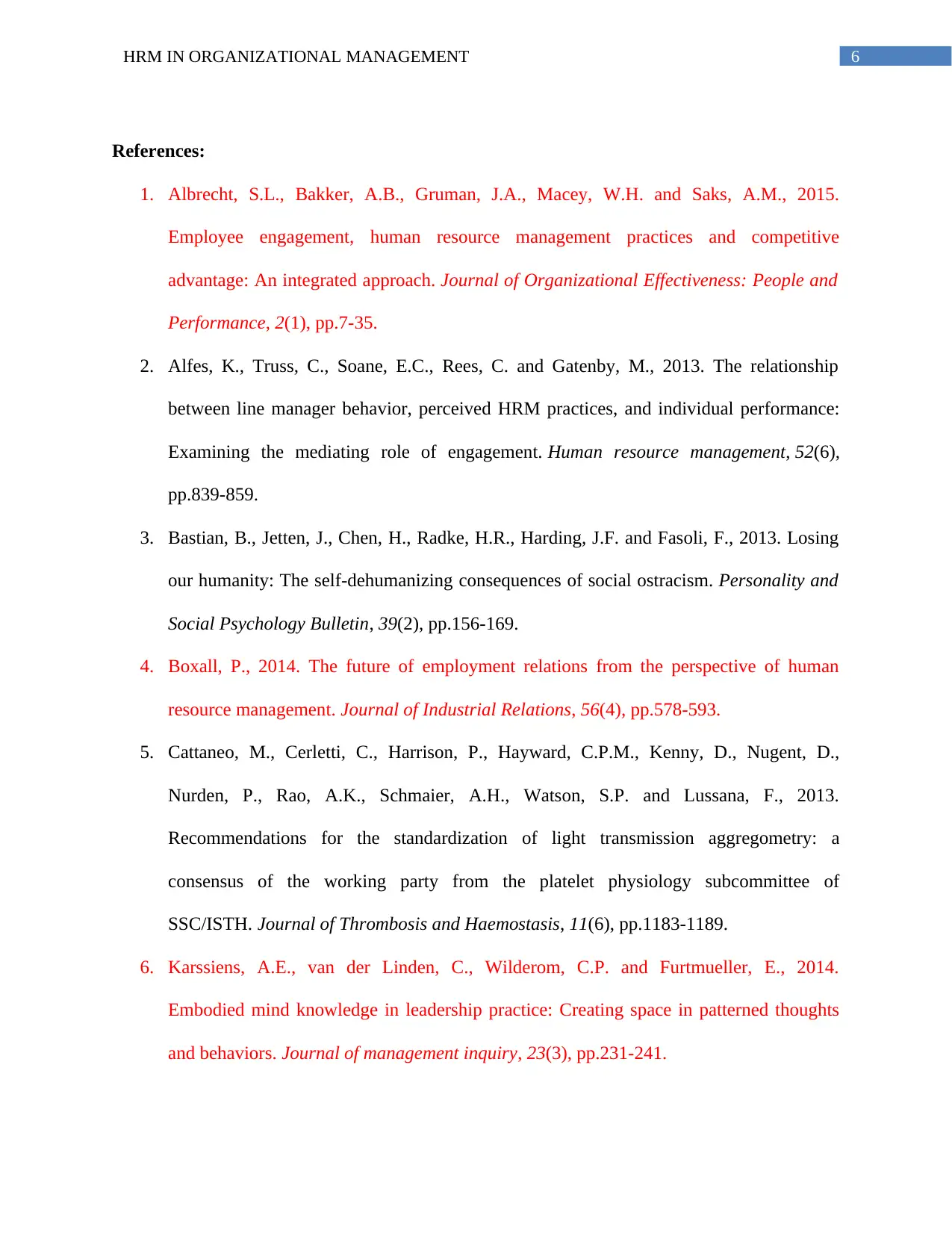
6HRM IN ORGANIZATIONAL MANAGEMENT
References:
1. Albrecht, S.L., Bakker, A.B., Gruman, J.A., Macey, W.H. and Saks, A.M., 2015.
Employee engagement, human resource management practices and competitive
advantage: An integrated approach. Journal of Organizational Effectiveness: People and
Performance, 2(1), pp.7-35.
2. Alfes, K., Truss, C., Soane, E.C., Rees, C. and Gatenby, M., 2013. The relationship
between line manager behavior, perceived HRM practices, and individual performance:
Examining the mediating role of engagement. Human resource management, 52(6),
pp.839-859.
3. Bastian, B., Jetten, J., Chen, H., Radke, H.R., Harding, J.F. and Fasoli, F., 2013. Losing
our humanity: The self-dehumanizing consequences of social ostracism. Personality and
Social Psychology Bulletin, 39(2), pp.156-169.
4. Boxall, P., 2014. The future of employment relations from the perspective of human
resource management. Journal of Industrial Relations, 56(4), pp.578-593.
5. Cattaneo, M., Cerletti, C., Harrison, P., Hayward, C.P.M., Kenny, D., Nugent, D.,
Nurden, P., Rao, A.K., Schmaier, A.H., Watson, S.P. and Lussana, F., 2013.
Recommendations for the standardization of light transmission aggregometry: a
consensus of the working party from the platelet physiology subcommittee of
SSC/ISTH. Journal of Thrombosis and Haemostasis, 11(6), pp.1183-1189.
6. Karssiens, A.E., van der Linden, C., Wilderom, C.P. and Furtmueller, E., 2014.
Embodied mind knowledge in leadership practice: Creating space in patterned thoughts
and behaviors. Journal of management inquiry, 23(3), pp.231-241.
References:
1. Albrecht, S.L., Bakker, A.B., Gruman, J.A., Macey, W.H. and Saks, A.M., 2015.
Employee engagement, human resource management practices and competitive
advantage: An integrated approach. Journal of Organizational Effectiveness: People and
Performance, 2(1), pp.7-35.
2. Alfes, K., Truss, C., Soane, E.C., Rees, C. and Gatenby, M., 2013. The relationship
between line manager behavior, perceived HRM practices, and individual performance:
Examining the mediating role of engagement. Human resource management, 52(6),
pp.839-859.
3. Bastian, B., Jetten, J., Chen, H., Radke, H.R., Harding, J.F. and Fasoli, F., 2013. Losing
our humanity: The self-dehumanizing consequences of social ostracism. Personality and
Social Psychology Bulletin, 39(2), pp.156-169.
4. Boxall, P., 2014. The future of employment relations from the perspective of human
resource management. Journal of Industrial Relations, 56(4), pp.578-593.
5. Cattaneo, M., Cerletti, C., Harrison, P., Hayward, C.P.M., Kenny, D., Nugent, D.,
Nurden, P., Rao, A.K., Schmaier, A.H., Watson, S.P. and Lussana, F., 2013.
Recommendations for the standardization of light transmission aggregometry: a
consensus of the working party from the platelet physiology subcommittee of
SSC/ISTH. Journal of Thrombosis and Haemostasis, 11(6), pp.1183-1189.
6. Karssiens, A.E., van der Linden, C., Wilderom, C.P. and Furtmueller, E., 2014.
Embodied mind knowledge in leadership practice: Creating space in patterned thoughts
and behaviors. Journal of management inquiry, 23(3), pp.231-241.
Paraphrase This Document
Need a fresh take? Get an instant paraphrase of this document with our AI Paraphraser
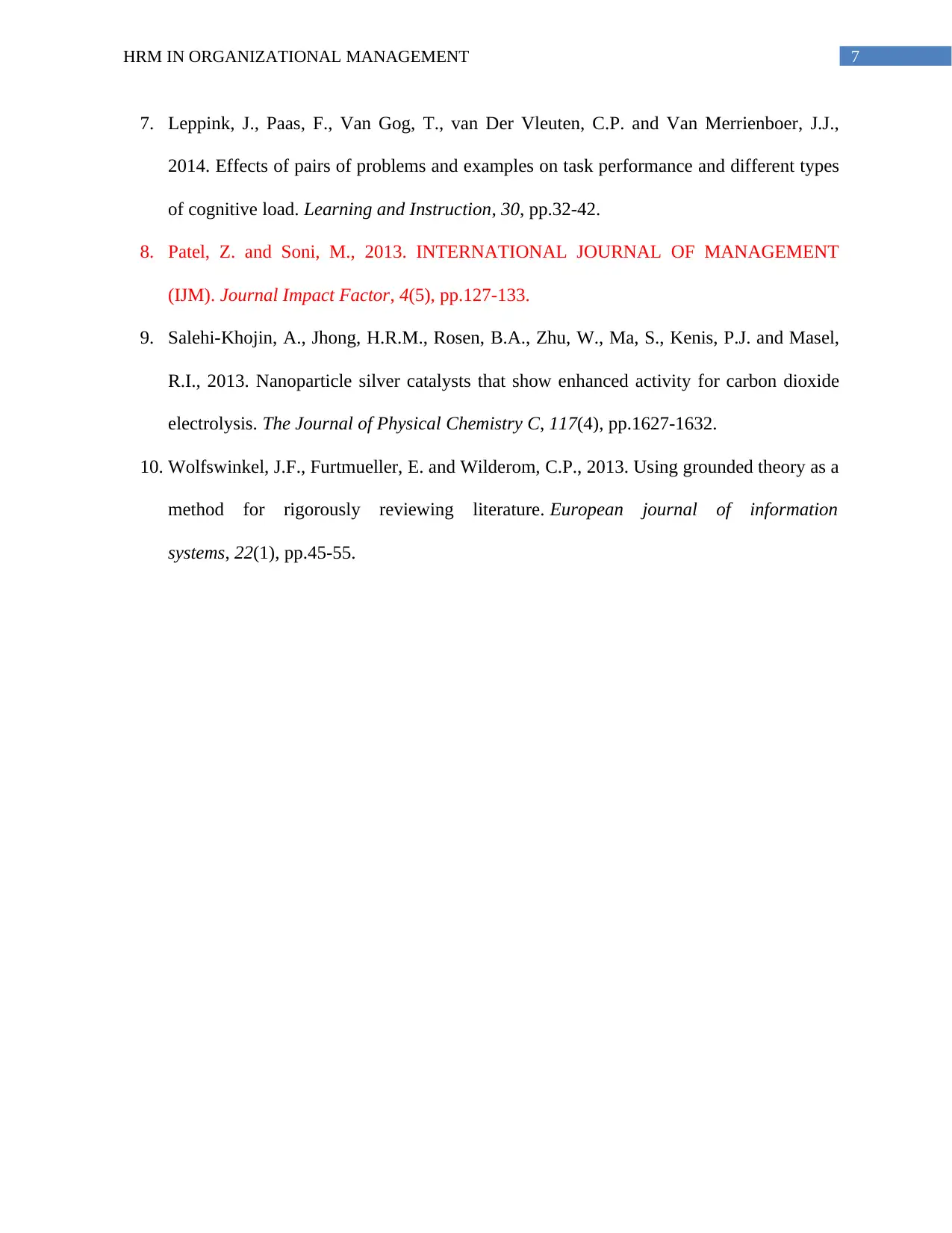
7HRM IN ORGANIZATIONAL MANAGEMENT
7. Leppink, J., Paas, F., Van Gog, T., van Der Vleuten, C.P. and Van Merrienboer, J.J.,
2014. Effects of pairs of problems and examples on task performance and different types
of cognitive load. Learning and Instruction, 30, pp.32-42.
8. Patel, Z. and Soni, M., 2013. INTERNATIONAL JOURNAL OF MANAGEMENT
(IJM). Journal Impact Factor, 4(5), pp.127-133.
9. Salehi-Khojin, A., Jhong, H.R.M., Rosen, B.A., Zhu, W., Ma, S., Kenis, P.J. and Masel,
R.I., 2013. Nanoparticle silver catalysts that show enhanced activity for carbon dioxide
electrolysis. The Journal of Physical Chemistry C, 117(4), pp.1627-1632.
10. Wolfswinkel, J.F., Furtmueller, E. and Wilderom, C.P., 2013. Using grounded theory as a
method for rigorously reviewing literature. European journal of information
systems, 22(1), pp.45-55.
7. Leppink, J., Paas, F., Van Gog, T., van Der Vleuten, C.P. and Van Merrienboer, J.J.,
2014. Effects of pairs of problems and examples on task performance and different types
of cognitive load. Learning and Instruction, 30, pp.32-42.
8. Patel, Z. and Soni, M., 2013. INTERNATIONAL JOURNAL OF MANAGEMENT
(IJM). Journal Impact Factor, 4(5), pp.127-133.
9. Salehi-Khojin, A., Jhong, H.R.M., Rosen, B.A., Zhu, W., Ma, S., Kenis, P.J. and Masel,
R.I., 2013. Nanoparticle silver catalysts that show enhanced activity for carbon dioxide
electrolysis. The Journal of Physical Chemistry C, 117(4), pp.1627-1632.
10. Wolfswinkel, J.F., Furtmueller, E. and Wilderom, C.P., 2013. Using grounded theory as a
method for rigorously reviewing literature. European journal of information
systems, 22(1), pp.45-55.
1 out of 8
Related Documents
Your All-in-One AI-Powered Toolkit for Academic Success.
+13062052269
info@desklib.com
Available 24*7 on WhatsApp / Email
![[object Object]](/_next/static/media/star-bottom.7253800d.svg)
Unlock your academic potential
Copyright © 2020–2025 A2Z Services. All Rights Reserved. Developed and managed by ZUCOL.





